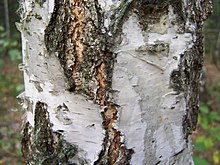Lupeol
| Structural formula | ||||||||||||||||||||||
|---|---|---|---|---|---|---|---|---|---|---|---|---|---|---|---|---|---|---|---|---|---|---|

|
||||||||||||||||||||||
| General | ||||||||||||||||||||||
| Surname | Lupeol | |||||||||||||||||||||
| other names |
|
|||||||||||||||||||||
| Molecular formula | C 30 H 50 O | |||||||||||||||||||||
| Brief description |
colorless solid |
|||||||||||||||||||||
| External identifiers / databases | ||||||||||||||||||||||
|
||||||||||||||||||||||
| properties | ||||||||||||||||||||||
| Molar mass | 426.72 g mol −1 | |||||||||||||||||||||
| Physical state |
firmly |
|||||||||||||||||||||
| density |
0.9457 g cm −3 (218 ° C ) |
|||||||||||||||||||||
| Melting point |
215 ° C |
|||||||||||||||||||||
| solubility |
|
|||||||||||||||||||||
| Refractive index |
1.4910 (218 ° C) |
|||||||||||||||||||||
| safety instructions | ||||||||||||||||||||||
|
||||||||||||||||||||||
| As far as possible and customary, SI units are used. Unless otherwise noted, the data given apply to standard conditions . Refractive index: Na-D line , 20 ° C | ||||||||||||||||||||||
Lupeol is a secondary plant substance that belongs to the pentacyclic triterpenes and belongs to the subgroup of lupans . It belongs to the alcohols (see also cycloalkanols ) and the alkenes . Lupeol is of interest for medical research as a potentially readily available anti-malarial and anti-cancer agent with low toxicity.
Occurrence
The natural substance lupeol occurs in the caper plant Crateva nurvala or the bark of birch trees .
Historical
Lupeol was discovered in the seeds of yellow lupins by Ernst Schulze and was first described in 1891. Gilbert Stork published a total synthesis of Lupeol in 1971 .
biosynthesis
Lupeol is ultimately formed from acetyl-CoA via the intermediate stage squalene . Chemical synthesis is also possible. Because of a stereochemical problem, it is a bit more expensive.
Effects
Lupeol shows antiprotozoal effects against Plasmodium falciparum in vitro . The effect is not fully understood and is being researched further.
Anti-inflammatory properties have been observed and are the subject of further research, for example the effect of Lupeol in the treatment of facial acne was investigated in a clinical study.
Inhibition of the growth of tumor cells was also observed. Different mechanisms of action have been demonstrated. Lupeol has been reported to be effective against stomach and lung cancer, that it shows good results in the treatment of breast cancer, and that it protects against alcohol-related stomach damage. Research is being carried out into the cases in which Lupeol is suitable as an adjuvant therapeutic agent .
The antimicrobial effect of Lupeol can be measured. Here the substance is regarded as the lead substance for the development of more effective derivatives.
literature
- Gallo M., Sarachine M .: Biological Activities of Lupeol. International Journal of Biomedical and Pharmaceutical Sciences 3 (Special Issue 1), 46-66; 2009 ( PDF )
Web links
- Entry on Lupeol at ChemicalBook
Individual evidence
- ↑ a b Lupeol data sheet (PDF) from Carl Roth , accessed on June 5, 2010.
- ↑ a b David R. Lide (Ed.): CRC Handbook of Chemistry and Physics . 90th edition. (Internet version: 2010), CRC Press / Taylor and Francis, Boca Raton, FL, Physical Constants of Organic Compounds, pp. 3-322.
- ^ F. Macdonald, Dictionary of pharmacological agents, ISBN 978-0-412-46630-4 .
- ↑ Lupeol (enzolifesciences)
- ↑ Lupeol data sheet at Sigma-Aldrich , accessed on May 9, 2017 ( PDF ).
- ↑ Arthur Likiernik: About the Lupeol . In: Reports of the German Chemical Society . tape 24 , no. 1 . Berlin January 1891, p. 183–186 , doi : 10.1002 / cber.18910240135 ( online at Gallica Bibliothèque nationale de France).
- ↑ Arthur Likiernik: About the vegetable lecithin and about some components of the legume shells . Inaugural dissertation. Zurich 1891 ( summary (E. Roth) in the Botanisches Centralblatt 1892 online [PDF]).
- ↑ a b Gilbert Stork , Shoichiro Uyeo, T. Wakamatsu, P. Grieco, J. Labovitz: Total synthesis of lupeol . In: Journal of the American Chemical Society . tape 93 , no. September 19 , 1971, p. 4945-4947 , doi : 10.1021 / ja00748a068 .
- ↑ Clinical Study for Topical Lupeol in Acne. In: ClinicalTrials.gov. US National Library of Medicine, 2014, accessed May 12, 2019 .
- ↑ MH Cháirez-Ramírez, MR Moreno-Jiménez, RF González-Laredo, JA Gallegos-Infante, Nuria Elizabeth Rocha-Guzmán: Lupane-type triterpenes and their anti-cancer activities against most common malignant tumors: A review . In: test magazine . November 30, 2016, p. Vol 15 (2016) - , doi : 10.17179 / excli2016-642 , PMID 28337107 , PMC 5318673 (free full text) - ( ifado.test [accessed on May 12, 2019]).
